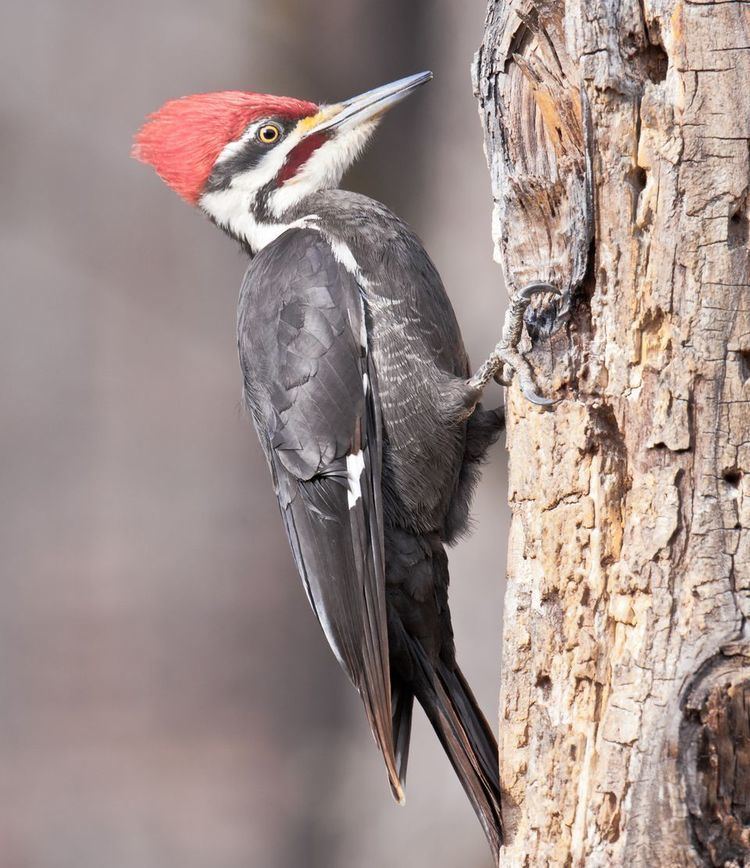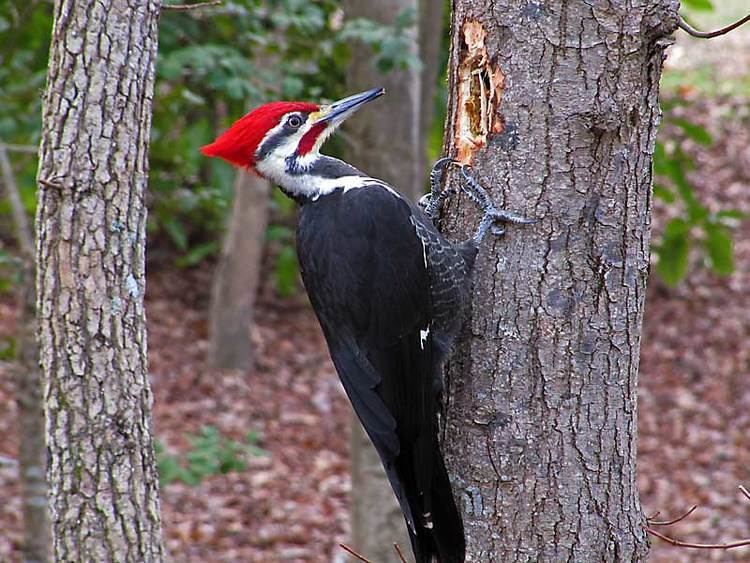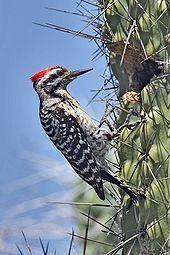Scientific name Picidae Rank Family | Phylum Chordata | |
 | ||
Lower classifications Great spotted woodpecker, European green woodpecker, Pileated woodpecker, Downy woodpecker, Black woodpecker | ||
Woodpeckers
The woodpeckers are part of the family Picidae, a group of near-passerine birds that also consist of piculets, wrynecks, and sapsuckers. Members of this family are found worldwide, except for Australia, New Guinea, New Zealand, Madagascar, and the extreme polar regions. Most species live in forests or woodland habitats, although a few species are known to live in treeless areas, such as rocky hillsides and deserts.
Contents
- Woodpeckers
- Through the lens acorn woodpecker
- General characteristics
- Global distribution
- Habitat requirements
- Behavior
- Drumming
- Diet and feeding
- Breeding
- Systematics and evolution
- List of genera
- References
The Picidae are just one of eight living families in the order Piciformes. Other members of Piciformes, such as the jacamars, puffbirds, barbets, toucans, and honeyguides, have traditionally been thought to be closely related to the woodpeckers, piculets, wrynecks, and sapsuckers. More recently, DNA sequence analyses have confirmed this view.

There are about 200 species and about 30 genera in this family. Many species are threatened or endangered due to loss of habitat or habitat fragmentation.

Through the lens acorn woodpecker
General characteristics

The woodpeckers range from very tiny piculets measuring no more than 7 cm (2.8 in) and weighing 7 g (0.25 oz) to large woodpeckers which can be more than 50 cm (20 in) in length. The largest surviving species is the great slaty woodpecker, which weighs 360–563 g (12.7–19.9 oz), but the probably extinct imperial woodpeckers and ivory-billed woodpeckers were both larger.

Woodpeckers have strong bills for drilling and drumming on trees and long sticky tongues for extracting food. Woodpecker bills are typically longer, sharper and stronger than the bills of piculets and wrynecks; however, their morphology is very similar. The bill's chisel-like tip is kept sharp by the pecking action in birds that regularly use it on wood. The beak consists of three layers; an outer sheath called rhamphotheca, made of scales formed from keratin proteins, an inner layer of bone which has a large cavity and mineralized collagen fibers, and a middle layer made of porous bone which connects the two other layers. Combined, this anatomy helps the beak absorb mechanical stress. Species of woodpecker and flicker that use their bills in soil or for probing as opposed to regular hammering tend to have longer and more decurved bills. Due to their smaller bill size, many piculets and wrynecks will forage in decaying wood more often than woodpeckers. The long sticky tongues, which possess bristles, aid these birds in grabbing and extracting insects deep within a hole of a tree. It had been reported that the tongue was used to spear grubs, but more detailed studies published in 2004 have shown that the tongue instead wraps around the prey before being pulled out.
Many of the foraging, breeding and signaling behaviors of woodpeckers involve drumming and hammering using the bill. To prevent brain damage from the rapid and repeated impacts, woodpeckers have a number of physical features designed to protect the brain. These include a relatively small and smooth brain, narrow subdural space, little cerebrospinal fluid (CSF) surrounding it to prevent it from moving back and forth inside the skull during pecking, the orientation of the brain within the skull (which maximises the contact area between the brain and the skull) and the short duration of contact. The skull is made of strong but compressible sponge-like bone which is most concentrated in the forehead and the back of the skull. Computer simulations have shown that 99.7 percent of the energy generated in pecking was stored in the form of strain energy, which was distributed throughout the bird's body, with only a tiny remaining fraction of the energy went into the brain. All the pecking also heats up the woodpecker's skull, which is part of the reason why they often peck in short bursts with brief breaks in between, giving the head some time to cool. The millisecond before contact with wood a thickened nictitating membrane closes, protecting the eye from flying debris. These membranes also prevent the retina from tearing. The nostrils are also protected; they are often slit-like and have special feathers to cover them. Woodpeckers are capable of repeated pecking on a tree at high decelerations on the order of 10,000 m/s2 (33,000 ft/s2) (1000 g).
Woodpeckers, piculets and wrynecks all possess feet consisting of four toes, the first (hallux) and the fourth facing backward and the second and third facing forward. This foot arrangement is good for grasping the limbs and trunks of trees. Members of this family can walk vertically up a tree trunk, which is beneficial for activities such as foraging for food or nest excavation. In addition to their strong claws and feet, woodpeckers have short strong legs. This is typical of birds that regularly forage on trunks. Exceptions are the black-backed woodpecker and the American and Eurasian three-toed woodpeckers, which have only three toes on each foot. The tails of all woodpeckers except the piculets and wrynecks are stiffened, and when the bird perches on vertical surfaces, the tail and feet work together to support it.
Global distribution
The woodpeckers have a mostly cosmopolitan distribution, although they are absent from Australasia, Madagascar, and Antarctica. They are also absent from some of the world's oceanic islands, although many insular species are found on continental islands. The true woodpeckers, subfamily Picinae, are distributed across the entire range of the family. The Picumninae piculets have a pantropical distribution, with species in Southeast Asia, Africa, and the Neotropics, with the greatest diversity being in South America. The second piculet subfamily, Nesoctitinae, has a single member, the Antillean piculet, which is restricted to the Caribbean island of Hispaniola. The wrynecks (Jynginae) are found exclusively in the Old World, with the two species occurring in Europe, Asia, and Africa.
The majority of woodpeckers are sedentary but there are a few examples of migratory species such as the rufous-bellied woodpecker and yellow-bellied sapsucker, and the Eurasian wryneck, which breeds in Europe and west Asia and migrates to the Sahel in Africa in the winter. More northerly populations of Lewis's woodpecker, northern flicker, Williamson's sapsucker, red-breasted sapsucker and red-naped sapsucker all move southwards in the fall in North America. Most woodpecker movements can be described as dispersive, such as when young birds seek territories after fledging, or eruptive, to escape harsh weather conditions. Several species are altitudinal migrants, for example the grey-capped woodpecker, which moves to lowlands from hills during the winter months The woodpeckers that do migrate do so during the day.
Habitat requirements
Overall, the woodpeckers are arboreal birds of wooded habitats. They reach their greatest diversity in tropical rainforests, but occur in almost all suitable habitats including woodlands, savannahs, scrublands, and bamboo forests. Even grasslands and deserts have been colonised by various species. These habitats are more easily occupied where a small number of trees exist, or, in the case of desert species like the Gila woodpecker, tall cacti are available for nesting in. Some are specialists and are associated with coniferous or deciduous woodland or even, like the acorn woodpecker, with individual tree genera (oaks in this case). Other species are generalists and are able to adapt to forest clearance by exploiting secondary growth, plantations, orchards and parks. In general, forest-dwelling species need rotting or dead wood on which to forage.
A number of species are adapted to spending a portion of their time feeding on the ground, and a very small minority have abandoned trees entirely and nest in holes in the ground. The ground woodpecker is one such species, inhabiting the rocky and grassy hills of South Africa, and the Andean flicker is another.
The Swiss Ornithological Institute has set up a monitoring program to record breeding populations of woodland birds. This has shown that deadwood is an important habitat requirement for the black woodpecker, great spotted woodpecker, middle spotted woodpecker, lesser spotted woodpecker, European green woodpecker and Eurasian three-toed woodpecker. Populations of all these species increased by varying amounts in the period 1990 to 2008. During this period, the amount of deadwood in the forest increased and the range of the white-backed woodpecker enlarged as it extended eastwards. With the exception of the green and middle spotted woodpeckers, the increase in the amount of deadwood is likely to be the major factor explaining the population increase of these species.
Two species of woodpeckers in the Americas, the ivory-billed woodpecker and the imperial woodpecker, have been considered extinct since the mid to late 20th century, though there have been possible but disputed sightings of ivory-billed woodpeckers in the United States since 2004, and a small population may linger in Cuba.
Behavior
The woodpeckers range from highly antisocial solitary species that are aggressive toward other members of their species, to species that live in groups. Group-living species tend to be communal group breeders. In addition to these species, a number of species may join mixed-species foraging flocks with other insectivorous birds, although they tend to stay at the edges of these groups. Joining these flocks allows woodpeckers to decrease their anti-predator vigilance and increase their feeding rate. Woodpeckers are diurnal, roosting at night inside holes. In most species the roost will become the nest during the breeding season.
Drumming
Drumming is a form of non-vocal communication used by most species of woodpecker and involves the bill being repeatedly struck on a hard surface with great rapidity. After a pause, the drum roll is repeated, each species having a pattern which is unique in the number of beats in the roll, the length of the roll, the length of the gap between rolls and the cadence. The drumming is mainly a territorial call, equivalent to the song of a passerine, with male birds drumming more frequently than females. The woodpecker chooses a surface that resonates, such as a hollow tree, and may use manmade structures such as gutters and downpipes. Drumming serves for the mutual recognition of conspecifics and plays a part in courtship rituals. Individual birds are thought to be able to distinguish the drumming of their mates and that of their neighbours.
Diet and feeding
The diet of woodpeckers consists mainly of insects and their grubs taken from living and dead trees, and other arthropods, along with fruit, nuts and sap from live trees. Ecologically, they help to keep trees healthy by keeping them from suffering mass infestations. The family is noted for its ability to acquire wood-boring grubs using their bills for hammering, but overall the family is characterized by its dietary flexibility, with many species being both highly omnivorous and opportunistic with a diet including ants, bird eggs, cactus fruits, lizards, nestlings, and insects. The insect prey most commonly taken are those found inside tree trunks, whether they are alive or rotten, and in crevices in the bark. These include beetles and their grubs, ants, termites, spiders, and caterpillars. These may be obtained either by gleaning or, more famously, by excavating wood. Having hammered a hole into the wood, the prey is excavated by a long barbed tongue. Woodpeckers consume beetles that burrow into trees, removing as many as 85 percent of emerald ash borer larvae from individual ash trees. They will also partake of millet and thistle seed from bird feeders.
The ability to excavate allows woodpeckers to obtain tree sap, an important source of food for some species. Most famously, the sapsuckers (genus Sphyrapicus) feed in this fashion, but the technique is not restricted to these, and others such as the acorn woodpecker and white-headed woodpecker also feed in this way. It was once thought that the technique was restricted to the New World, but Old World species, such as the Arabian woodpecker and great spotted woodpecker, also feed in this way.
Great spotted woodpeckers also attack nestboxes, especially those with tits nesting inside. They will drag nesting material out of the box and both eggs and chicks are lifted out and either eaten in situ or taken away.
Nestboxes fitted with a metal plate can deter woodpeckers from pecking away at the entrance hole. However, determined woodpeckers may try to make holes elsewhere on the box. A study by Lancaster University found that when covered in wire mesh, only 1 out of 48 blue tit nest boxes were predated. However, this may provide a climbing perch for other predators such as squirrels.
Breeding
All members of the family Picidae nest in cavities. Almost every species nests in tree cavities, although, in deserts, some species nest inside holes in cactus and a few species nest in holes dug into the earth. Woodpeckers also excavate nest holes in residential and commercial structures as well as wood utility poles. Woodpeckers and piculets will excavate their own nests, but wrynecks will not. The excavated nest is usually only lined from the wood chips produced as the hole was made. Many species of woodpeckers excavate one hole per breeding season, sometimes after multiple attempts. It takes around a month to finish the job. Abandoned holes are used by other birds and mammals that are secondary cavity nesters. Because nesting holes are in great demand by other cavity nesters, woodpeckers face competition for the nesting sites they excavate from the moment the hole becomes usable. This may come from other species of woodpecker, or other cavity nesting birds like swallows and starlings. Woodpeckers may aggressively harass potential competitors, and also use other strategies to reduce the chance of being usurped from their nesting site; for example the red-crowned woodpecker digs its nest in the underside of a small branch, which reduces the chance that a larger species will take it over and expand it.
Members of Picidae are typically monogamous, with a few species breeding cooperatively and some polygamy reported in a few species. Polyandry, where a female raises two broods with two separate males, has also been reported in the West Indian woodpecker. Another unusual social system is that of the acorn woodpecker, which is a polygynandrous cooperative breeder where groups of up to 12 individuals breed and help to raise the young. Young birds from previous years may stay behind to help raise the group's young, and studies have found reproductive success for the group goes up with group size, but individual success goes down. Birds may be forced to remain in groups due to a lack of habitat to disperse to.
A pair will work together to help build the nest, incubate the eggs and raise their altricial young. However, in most species the male does most of the nest excavation and takes the night shift while incubating the eggs. A nest will usually consist of 2–5 round white eggs. Since these birds are cavity nesters, their eggs do not need to be camouflaged and the white color helps the parents to see them in dim light. The eggs are incubated for about 11–14 days before the chicks are born. It takes about 18–30 days before the young are ready to leave the nest.
Systematics and evolution
The phylogeny has been updated according to new knowledge about convergence patterns and evolutionary history. Most notably, the relationship of the picine genera has been largely clarified, and it was determined that the Antillean piculet is a surviving offshoot of proto-woodpeckers.
The evolutionary history of this group is not well documented, but the known fossils allow some preliminary conclusions: the earliest known modern picids were piculet-like forms of the Late Oligocene, about 25 million years ago (mya). By that time, however, the group was already present in the Americas and Europe, and it is hypothesized that they actually evolved much earlier, maybe as early as the Early Eocene (50 mya). The modern subfamilies appear to be rather young by comparison; until the mid-Miocene (10–15 mya), all picids seem to have been small or mid-sized birds similar to a mixture between a piculet and a wryneck. On the other hand, there exists a feather enclosed in fossil amber from the Dominican Republic, dated to about 25 mya, which seems to indicate that the Nesoctitinae were already a distinct lineage by then.
Prehistoric representatives of the extant Picidae genera are treated in the genus articles. An enigmatic form based on a coracoid found in Pliocene deposits of New Providence, Bahamas, has been described as Bathoceleus hyphalus and probably also is a woodpecker.
List of genera
Family: Picidae
